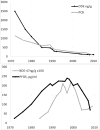Emerging exposures of developmental toxicants
- PMID: 28059904
- PMCID: PMC5473289
- DOI: 10.1097/MOP.0000000000000455
Emerging exposures of developmental toxicants
Abstract
Purpose of review: The purpose of this review is to identify emerging developmental toxicants that are understudied in children's health. Exposures may arise from new products designed to improve utility, to reduce toxicity, or to replace undesirable chemicals. Exposures to less-toxic chemicals may also be significant if they are very commonly used, thereby generating widespread exposure. Sources of exposure include the workplace, personal, home, and office products; food, water, and air.
Recent findings: We describe eight exposure categories that contain numerous potential developmental toxicants. References are discussed if reported in PubMed during the past decade at least 10 times more frequently than in 1990-2000. Examples included phthalates, phenols, sunscreens, pesticides, halogenated flame retardants, perfluoroalkyl coatings, nanoparticles, e-cigarettes, and dietary polyphenols. Replacements are often close structural homologs of their precursors. We suggest biomonitoring as preferred means of exposure assessment to emerging chemicals. Some existing analytic methods would require minimal modification to measure these exposures, but others require toxicokinetic and analytic investigation.
Summary: A deliberate strategy for biomonitoring of emerging replacement chemicals is warranted, especially in view of concerns regarding developmental toxicity. To prevent adverse health effects, it is important to characterize such exposures before they become widely disseminated.
Conflict of interest statement
COI: None declared.
Figures
References
-
- Gabb HA, Blake C. An Informatics Approach to Evaluating Combined Chemical Exposures from Consumer Products: A Case Study of Asthma-Associated Chemicals and Potential Endocrine Disruptors. Environ Health Perspect. 2016;124:1155–1165. In the moment when epidemiology is realizing that more than asingle chemical exists in the body, this paper codifies the presence of multiple chemicals in mnay products – true mixed exposures. Thhsu while exposure biomarkers mesure one at a time, their sources and their biological activity might be better characterized if synchronous exposures. - PMC - PubMed
-
- Ekowati Y, Buttiglieri G, Ferrero G, Valle-Sistac J, Diaz-Cruz MS, Barcelo D, Petrovic M, Villagrasa M, Kennedy MD, Rodriguez-Roda I. Occurrence of pharmaceuticals and UV filters in swimming pools and spas. Environ Sci Pollut Res Int. 2016;23:14431–14441. - PubMed
-
- Ejaredar M, Nyanza EC, Ten EK, Dewey D. Phthalate exposure and childrens neurodevelopment: A systematic review. Environ Res. 2015;142:51–60. - PubMed
-
- Goodman M, Lakind JS, Mattison DR. Do phthalates act as obesogens in humans? A systematic review of the epidemiological literature. Crit Rev Toxicol. 2014;44:151–175. - PubMed
Publication types
MeSH terms
Substances
Grants and funding
- R21 ES024707/ES/NIEHS NIH HHS/United States
- U2C ES026555/ES/NIEHS NIH HHS/United States
- U2C ES026561/ES/NIEHS NIH HHS/United States
- P30 ES007048/ES/NIEHS NIH HHS/United States
- P30 ES010126/ES/NIEHS NIH HHS/United States
- P01 ES022845/ES/NIEHS NIH HHS/United States
- R21 HD084812/HD/NICHD NIH HHS/United States
- P30 ES023515/ES/NIEHS NIH HHS/United States
- U2C ES026560/ES/NIEHS NIH HHS/United States
- U01 ES019454/ES/NIEHS NIH HHS/United States
- R01 ES021777/ES/NIEHS NIH HHS/United States
- P30 ES019776/ES/NIEHS NIH HHS/United States
LinkOut - more resources
Full Text Sources
Other Literature Sources
Medical
Research Materials
Miscellaneous



